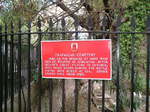
Gibraltar (Battle of Trafalgar) 2005
In 2005, I visited Southern Spain. Whilst I was there I nipped over to Gibraltar and visited at Cemetery that had some Battle of Trafalgar men in it.
The Battle of Trafalgar saw the British decisively defeat a combined French and Spanish fleet on 21st October 1805 in the most significant naval battle of the Napoleonic wars. A Royal Navy Fleet of 27 ships of the line destroyed an allied French and Spanish fleet of 33 ships of the line west of Cape Trafalgar in south-west Spain. The French and Spanish lost 22 ships, while the British lost none. The British commander Admiral Lord Nelson died late in the battle, by which time he had ensured his place as Britain's greatest naval hero. Indeed he came in the top 5 of the Greatest Britons on the BBC TV Series.
It was part of the War of the 3rd coalition and a pivotal naval battle of the 19th Century. The British victory spectacularly confirmed the naval supremacy that Britain had established during the 18th Century. However, by the time it was fought, Napoleon had abandoned his plans to invade southern England and instead was defeating Britain's allies in Germany. Although I have never been to Cape Trafalgar, I visited Gibraltar where there is a British War Cemetery for some of the men who died during the battle. Most of the men were buried at sea in the true traditional naval way, but some were buried at Gibraltar.
Although the name of the cemetery commemorates the Battle of Trafalgar, only two of those who are buried here actually died of wounds suffered in the battle (Lieut. William Forster of the Royal Marine Corps of H.M.S. Mars and Lieut. Thomas Norman of H.M.S. Columbus-grave numbers 121 and 101). Most of those who died at Trafalgar were buried at sea, and Lord Nelson’s body was transported to London for a state funeral. Wounded seamen were brought to Gibraltar, and those who died later of their wounds were buried just to the north of Charles V Wall, on the opposite side of Trafalgar Cemetery, a small plaque was recently placed there to commemorate the site

